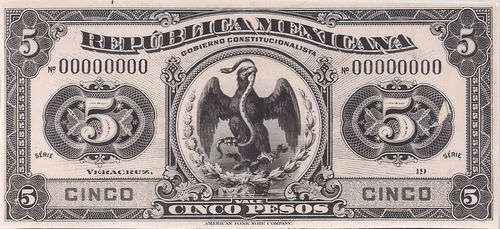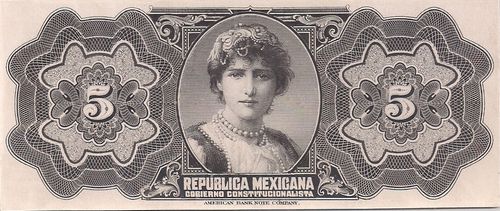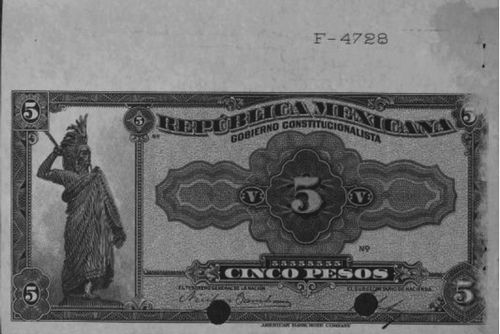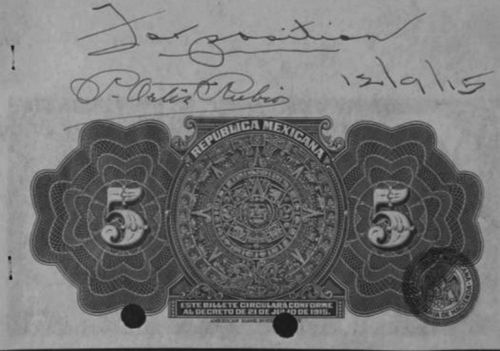American Bank Note Company negotiations
by Cedrian López Bosch
In early 1915 Pascual Ortiz Rubio, introduced by Austin P. Kelley, a member of the New York Stock Exchange, and Thomas B. Hardin of the law firm of Hardin, Hess and Ferguson, had a meeting in New York with L. Claudet, Vice-President of the American Bank Note CompanyABNC, folder 210, Republic of Mexico (1915 (Feb) – 1916 (June).
On 5 March the ABNC quoted to Luis Cabrera, for supplying 10,000,000 $5, 5,000,000 $10, 2,000,000 $20 and 1,000,000 $50 notes. The notes were to be printed from the best engravings on the face and back, with multicolour on the face in addition, on the company’s best bank note planchetted paper. Before proceeding with engravings the company would prepare complete models, to be submitted for approval to whomever Cabrera appointed in New York to decide on the matter.
On 5 May Pascual Ortiz Rubio wrote asking about another issue of about 10,000,000 $5 notes. He wanted to know if the ABNC could use the plates in five colours which he showed them or if it would be necessary to make new plates. Two days later Claudet met Ortiz Rubio and gave him a verbal price for 10,000,000 $5 notes; the size to be exactly the same as the Banco del Pichincha $1 note, with one steel printing on face and back, and one litho printing on face. Claudet expected a model to be ready within a few days, and this was delivered, on 16 May, to Montes de Oca at Francisco S. Elias’s offices in New York.


Note that this modelorder 6345, dated 17 May 1915 is datelined "VERACRUZ, 19 " as Carranza had transferred his capital there at the end of 1914.
On 30 May Claudet wrote with the terms of the proposed contract, and these Ortiz Rubio forwarded to VeracruzABNC, folder 210, Republic of Mexico (1915 (Feb) – 1916 (June).
Carranza issued his decree creating the infalsificables on 21 July 1915 and on the same day he authorised Cabrera to make arrangements in the United States for the printing of the 250,000,000 pesos in bank notes referred to in the decree. Negotiations took timeWhile in New York, Cabrera reported to Carranza: “We start work on the new issue as soon as I receive money to sign a FOVO contract, I ask Nieto for one hundred thousand, I hope to leave hospital next week, but from here I will attend to the issue of notes.” CEHM, Fondo XXl-4, telegram of Luis Cabrera to Carranza, 18 August 1915., and on 2 September the ABNC replied to various questions raised by Pruneda, including discounting the use of a watermark”A Watermark would weaken the quality of paper because in order to make a good watermark it is necessary to introduce in the manufacture of the paper a certain quantity of cotton, and this is only done on a more inferior quality, our bank note paper containing at least 90 per cent of linen. A watermark disappears after the notes have been in use a very short time.” and silk fibres (“the monopoly of the United States Government”). On 13 September the ABNC handed Cabrera a revised form of the contract under consideration, where the company had conceded a few points, including enlarging the size of practically every note without increasing the prices quoted, reducing the cost of the $100 note and changing the payment schedule. Since Cabrera had mentioned that the Government wanted to receive a note which could be placed in circulation upon its receipt, the ABNC embodied a price for printing the seal of the Constitutionalist Government on the notes.
The original contract, signed by Luis Cabrera on 15 September, was for 10,000,000 $5 notes (series C, numbered 000001 to 1000000, then A000001 to A1000000 through to J000001 to J1000000 (skipping the lettter “I”); 5,000,000 $10 notes (Series I, 000001 to 1000000, then A000001 to A1000000 through to D000001 to D1000000; 2,500,000 $20 notes (Series X, 000001 to 1000000, A000001 to A1000000 and B000001 to B500000); 1,000,000 $50 notes (Series E, 000001 to 1000000) and 500,000 $100 notes (Series M, 000001 to 500000)The ABNC order numbers were F-4728 for the $5, F-4745 for the $10, F-4747 for the $20, F-4746 for the $50 and F-4748 for the $100..
The five denominations were made with steel plates, are in four different sizes (the $5 2⅝ by 5½ inches; the $10, 3 by 5½ inches; the $20 3 by 6⅛ inches, and the $50 and $100 3⅜ by 7 inches), and with vignettes engraved with a burin or by etching, specific for each denomination on the face and with a common reverse. The five pesos were printed in 15 notes per sheet, the 10 and 20 pesos, and the 50 and 100 pesos in 12 and 8 subject sheets, respectively.
The designs were still being finalised and following the contract the ABNC’s Engraving Department was instructed to make the following changes :
(1) the title “República Mexicana” on the face of each note was to be the most prominent. - not “Gobierno Constitutionalista” as originally instructed.
(2) each denomination counter on the face was to be different from the rest.
(3) the backs of all the notes were to be lathe work only, without a border so that the general effect would not be square at the corners.
(4) on the $5 back the figures “5” appearing at each side of the Aztec calendar should be smaller ones.
(5) on the $10 face the title “República Mexicana”should be most prominent, the multi words “Diez”in the signature panel should be removed, the colours for the multi tint to be blue, brown and red, with the blue as the all over tint, and the panels in the four corners should each be differentABNC, folder 210, Republic of Mexico (1915 (Feb) – 1916 (June).
On 21 September Claudet wrote to Louis RoumagnacLuis Roumagnac was a Frenchman who held himself out as a middleman, though neither Blackmore, the ABNC’s resident agent in Mexico City, nor the New York head office thought much of him.
Thus on 3 January 1916 the ABNC, in response to a verbal request, gave him a quotation for furnishing the Mexican Government with the following: ten million $1 notes, five million $2, twelve million $5, seven million $10, three million $20, one and a half million $50 and 750,000 $100, 200,000 $500 and 100,000 $1,000 notes. The $5, $10, $20, $50 and $100 would be printed in accordance with the contract already executed with Luis Cabrera on 15 September 1915, whilst the $1, $2, $500 and $1,000 would be new issues, with vignettes drawn from stock unless the government decided otherwise. (ABNC, folder 210, Republic of Mexico (1915 (Feb) – 1916 (June)).
Roumagnac was also involved in the ill-fated attempt to establish the Banco del Estado de Oaxaca. about a request that they prepare a sketch, as suggested by Luis Cabrera, representing a city in flames in a valley with a background of mountains and a Mexican eagle rising from the flames to symbolise the victory of the revolution. He repeated the the verbal objections that he had made. “To get our artist to execute such a sketch as requested would require several weeks before he could conceive such a composition and after he would have sketched his ideas on paper several weeks more would be required to make a finished drawing necessary to engrave from. To embody such a composition in a large drawing and reduce it down to a size so that it could be engraved for the 100 Pesos note would make it so small they would lose all the effect that you desire to obtain”. He added “You will recall that when we were discussing the subject of vignettes for the Mexican notes I brought to your special attention the enclosed vignette which, at the time you visited our plant, was being engraved and had just been finished. You asked me at the time to reserve the same for you, which we have done and I think this I think that it will make a very handsome subject for the 100 Peso notes. It will of course be understood that this vignette, if selected by you, can never be employed on any other bank notes or securities” ABNC, folder 210, Republic of Mexico (1915 (Feb) – 1916 (June).
On 7 October Luis Cabrera wrote that Pasqual Ortiz Rubio was appointed “especially to take care of the work in connection with the printing of the notes referred to in the contract made by me with your company. Therefore it must be understood that Mr. Ortiz Rubio is authorised to approve the final models and carry out all other details mentioned in the contract.” So, on 11 December the ABNC gave Ortiz Rubio proof of “the vignette of the Interior Scene which is to appear on one of your notes; and a Brass Seal and three proofs of the face and back of the $5 note for his approval. On 14 December the ABNC gave its order desk a new electrotype which has been approved and is to be used for stamping on the backs of the 10’s, 20’s, 50’s and 100’s. On these notes the impression of the seal is to appear in the upper left hand corner. On the 5’s, which we are now printing with a seal, we shall continue to use the present electrotype, putting the seal in the lower right hand corner, as has already been approved.” The same day it sent Ortiz Rubio a die proof of the 100 Peso Face, and impression of a new electro which they had prepared for use in stamping the seals on the back of the notes. “This we think is more in accordance with your idea, than our original one was. However, we still must point out to you with very little usage, the lines in the eagle’s head will become thick and eventually print as though it were a solid figure, given the idea of a silhouette rather than standing out in relief. We simply mentioned this for your information, knowing as we do that it is your desire, under any and all conditions, to have a black eagle. If this seal meets with your approval, will you be kind enough to approve it and return it with the 100 Peso face die. We might further explain that he is our intention to continue putting the present seal on the 5 Peso notes in the lower right hand corner, as was approved by you: and if the new electro is satisfactory, we would use it on the other denominations, placing it in such a position that as much as possible of the eagle and text will appear on white paper.” Ortiz Rubio approved the vignette on 15 DecemberABNC, folder 210, Republic of Mexico (1915 (Feb) – 1916 (June).


$5 note approved by Pascual Ortiz Rubio on 9 December 1915
The ABNC began shipping the $5 note on 16 December.
On 3 January 1916 Ortiz Rubio received a die of the $50 face.
On 14 January Ortiz Rubio wrote to Claudet that he had been instructed by Luis Cabrera to ask for the cost of engraving four steel plates for the printing of $500 and $1,000 notes, and the price for 500,000 $100, 200,000 $500 and 100,000 $1,000 notes.
On 6 February the Order Desk was told to place the typed seal on the $10 note to be placed in the upper right hand corner and not upper left as previously called for.
In late February Jorge U. Orozco took over from Ortiz Rubio as the latter left for Morelia "on an urgent personal matter"the illness and death of his mother, though he hoped to be back within a month. Then, on 9 March, Alfredo Caturegli, as Agente Financiera del Gobierno de México in New York, took over the commissionABNC, folder 210, Republic of Mexico (1915 (Feb) – 1916 (June).
Consignments of notes from contract of 15 September 1915
| Date | Shipped to Veracruz via S.S. | Value | Series | from | to | Number |
| 16 December 1915 | "Esperanza" | $5 | C | 000001 | 150000 | 150,000 |
| 29 December 1915 | "Monterey" | $5 | C | 150001 | 1000000 | 850,000 |
| 11 January 1916 | "Esperanza" | $5 | C | A 000001 | A1000000 | 1,000,000 |
| 19 January 1916 | "Camaguay" | $5 | C | B 000001 | B 750000 | 750,000 |
| 26 January 1916 | "Monterey" | $5 | C | B 750001 | B 000000 | 750,000 |
| C 000001 | C 500000 | |||||
| $100 | M | 000001 | 050000 | 50,000 | ||
| 9 February 1916 | "Esperanza" | $5 | C | C 500001 | C1000000 | 1,500,000 |
| D 000001 | D1000000 | |||||
| $100 | M | 050001 | 250000 | 200,000 | ||
| 23 February 1916 | "Monterey" | $5 | C | E 000001 | E1000000 | 1,500,000 |
| F 000001 | F 500000 | |||||
| $10 | I | 000001 | 200000 | 200,000 | ||
| $20 | X | 000001 | 100000 | 100,000 | ||
| $50 | E | 000001 | 050000 | 50,000 | ||
| $100 | M | 250001 | 350000 | 100,000 | ||
| 7 March 1916 | "Esperanza" | $5 | C | F 500001 | F1000000 | 1,250,000 |
| G 000001 | G 750000 | |||||
| $10 | I | 200001 | 700000 | 500,000 | ||
| $20 | X | 100001 | 400000 | 300,000 | ||
| $50 | E | 050001 | 200000 | 150,000 | ||
| $100 | M | 350001 | 500000 | 150,000 | ||
| 15 March 1916 | "Borgium" | $5 | C | G 750001 | G1000000 | 2,250,000 |
| H 000001 | H1000000 | |||||
| J 000001 | J1000000 | |||||
| $10 | I | 700001 | 1000000 | 300,000 | ||
| $20 | X | 400001 | 500000 | 100,000 | ||
| $100 | M | 200001 | 300000 | 100,000 | ||
| 22 March 1916 | "Monterey" | $10 | I | A 000001 | A 150000 | 150,000 |
| $20 | X | 500001 | 600000 | 100,000 | ||
| $100 | M | 300001 | 500000 | 200,000 | ||
| 29 March 1916 | "Kotonia" | $10 | I | A 150001 | A 750000 | 600,000 |
| $20 | X | 600001 | 1000000 | 400,000 | ||
| $100 | M | 500001 | 650000 | 150,000 | ||
| 5 April 1916 | "Esperanza" | $10 | I | A 750001 | A1000000 | 750,000 |
| B 000001 | B 500000 | |||||
| $20 | X | A 000001 | A 500000 | 500,000 | ||
| $50 | E | 650001 | 850000 | 200,000 | ||
| 19 April 1916 | "Monterey" | $10 | I | B 500001 | B1000000 | |
| C 000001 | C1000000 | 1,500,000 | ||||
| $20 | X | A 500001 | A1000000 | |||
| B 000001 | B 500000 | 1,000,000 | ||||
| $50 | E | 850001 | 1000000 | 150,000 | ||
| 28 April 1916 | $10 | I | D 000001 | D1000000 | 1,000.000 |
According to Undersecretary Nieto, the notes would have been delivered to the commissioner José Cuevas Gutiérrez, who was then manager of the Commercial Exporting Agency in Veracruz, who would keep them in a safe place while the issue was madeCEHM, Fondo XXl-4, telegram of Rafael Nieto to Carranza, 20 January 1916. In March, these notes would be transferred from Veracruz to the Federal DistrictCEHM, Fondo XXl-4, telegram of Carranza to Rafael Nieto, 16 March 1916.
On 3 April 1916 Carranza increased the amount of infalsificables to $500,000,000, so on 10 April Caturegli increased the ABNC order by 2,500,000 $20, 1,000,000 $50 and 500,000 $100. However, It was found that the Mexican government required more notes in small rather than large denominations, and so this order was later cancelled and replaced on 8 May by a verbal order for an additional 8,950,000 notes with a total value of 100,000,000 pesos, confirmed the following day. This contract, of 9 May, was for 5,000,000 $5 notes (Series C, K000001 to K1000000 through to P000001 to P1000000 (skipping the lettter “O”); 2,500,000 $10 (Series I, E0000001 to E1000000, F000001 to F1000000 and G00001 to G500000), 1,000,000 $20 (Series X, B500001 to B1000000 and C000001 to C500000); 300,000$50 (Series E, A0000001 to A30000) and 150,000 $100 (Series M, 500001 to 6500000)The ABNC order numbers were F-4964 for the $5, F-4955 for the $10, F-4924 for the $20, F-4925 for the $50 and F-4926 (alt. F-4931) for the $100..
Consignments of notes from contract of 9 May 1916
| Date | Shipped to Veracruz via S.S. | Value | Series | from | to | Number |
| 17 May 1916 | "Monterey" | $20 | X | B 500001 | B 600000 | 100,000 |
| 24 May 1916 | "Estonia" | $20 | X | B 600001 | B1000000 | 400,000 |
| $50 | E | A 000001 | A 100000 | 100,000 | ||
| 31 May 1916 | "Esperanza" | $20 | X | C 000001 | C 300000 | 300,000 |
| $50 | E | A 100000 | A 200000 | 100,000 | ||
| 8 June 1916 | "Borgium" | $10 | I | E 000001 | E 300000 | 300,000 |
| $20 | X | C 300001 | C 500000 | 200,000 | ||
| $50 | E | A 200001 | A 300000 | 100,000 | ||
| 14 June 1916 | "Monterey" | $10 | I | E 300001 | E1000000 | 700,000 |
| $100 | M | 500001 | 650000 | 150,000 | ||
| 28 June 1916 | "Esperanza" | $5 | C | K 000001 | K1000000 | 2,000,000 |
| L 000001 | L1000000 | |||||
| $10 | I | F 000001 | F1000000 | 1,500,000 | ||
| G 000001 | G 500000 | |||||
| 11 July 1916 | "Monterey" | $5 | C | M 000001 | M1000000 | 3,000,000 |
| N 000001 | N1000000 | |||||
| P 000001 | P1000000 |
Finally, on 18 August 1916 Caturegli placed another order for an additional 10,000,000 $5 and 5,000,000 $10 notes. The $5 notes were Series C, Q000001 to Q1000000 through to Z000001 to Z1000000, and the $10 notes Series I, G500001 to G1000000, and H000001 to H1000000 through to M000001 to M500000 (skipping the lettter “I”)The ABNC order numbers were F-5035 for the $5 and F-5036 for the $10..
On 6 September Caturegli instructed that of future shipments, 60% should be sent to Veracruz, 10% to the Administrador de la Aduana at Nogales, Sonora, 10% to the Administrador de la Aduana at Ciudad Juárez, Chihuahua and the balance of 20% to the Administrador de la Aduana at Laredo, Tamaulipas, but six days later altered the instructions for the first two future shipments to 80% to Laredo, 10% to Ciudad Juárez and 10% to Nogales. On 3 October he again modified his instructions so that the deliveries would be made, in the first instance, to the Wells Fargo & Company, Express, on the American side of the border, instructing the Express Company to hold on the American side of the border their respective shipments and to deliver them there to the “Administrador de la Aduana”, demanding before delivery the proper identification.
Consignments of notes from contract of 18 August 1916
| Date | Consigned to | Value | Series | from | to | Number |
| 20 Sept. 1916 |
Laredo | $5 | C | Q 000001 | Q 400000 | 400,000 |
| $10 | I | G 500001 | G 900000 | 400,000 | ||
| Nogales | $5 | C | Q 400001 | Q 450000 | 50,000 | |
| $10 | I | G 900001 | G 950000 | 50,000 | ||
| El Paso | $5 | C | Q 450001 | Q 500000 | 50,000 | |
| $10 | I | G 950001 | G1000000 | 50,000 | ||
| 4 Oct. 1916 | Laredo | $5 | C | Q 500001 | Q1000000 | 800,000 |
| R 000001 | R 300000 | |||||
| $10 | I | H 000001 | H 800000 | 800,000 | ||
| Nogales | $5 | C | R 300001 | R 400000 | 100,000 | |
| $10 | I | H 800001 | H 900000 | 100,000 | ||
| El Paso | $5 | C | R 400001 | R 500000 | 100,000 | |
| $10 | I | H 900001 | H1000000 | 100,000 | ||
| 17 Oct. 1916 | Veracruz, per S. S. "Esperanza" | $5 | C | R 500001 | R1000000 | 1,500,000 |
| S 000001 | S1000000 | |||||
| $10 | I | J 000001 | J1000000 | 1,200,000 | ||
| K 000001 | K 200000 | |||||
| Laredo | $5 | C | T 000001 | T 500000 | 500,000 | |
| $10 | I | K 200001 | K 600000 | 400,000 | ||
| Nogales | $5 | C | T 500001 | T 750000 | 250,000 | |
| $10 | I | K 600001 | K 800000 | 200,000 | ||
| El Paso | $5 | I | T 750001 | T1000000 | 250.000 | |
| $10 | C | K 800001 | K1000000 | 200,000 | ||
| 31 Oct. 1916 | Veracruz, per S. S. "Monterey" | $5 | C | U 000001 | U1000000 | 1,500,000 |
| V 000001 | V 500000 | |||||
| $10 | I | L 000001 | L 600000 | 600,000 | ||
| Laredo | $5 | C | V 500001 | V1000000 | 500,000 | |
| $10 | I | L 600001 | L 800000 | 200,000 | ||
| Nogales | $5 | C | W 000001 | W 250000 | 250,000 | |
| $10 | I | L 800001 | L 900000 | 100,000 | ||
| El Paso | $5 | C | W 250001 | W 500000 | 250.000 | |
| $10 | I | L 900001 | L1000000 | 100,000 | ||
| 13 Nov. 1916 | Veracruz, per S. S. "Esperanza" | $5 | C | W 500001 | W1000000 | 2,100,000 |
| X 000001 | X1000000 | |||||
| Y 000001 | Y 600000 | |||||
| $10 | I | M 000001 | M 300000 | 300.000 | ||
| Laredo | $5 | C | Y 600001 | Y1000000 | 700,000 | |
| Z 000001 | Z 300000 | |||||
| $10 | I | M 300001 | M 400000 | 100,000 | ||
| Nogales | $5 | C | Z 650001 | Z1000000 | 350,000 | |
| $10 | I | M 450001 | M 500000 | 50,000 | ||
| El Paso | $5 | C | Z 300001 | Z 650000 | 350,000 | |
| $10 | I | M 400001 | M 450000 | 50,000 |
For further ABNC correspondence and negotiations on the printing of $1 and $2 notes see here.
